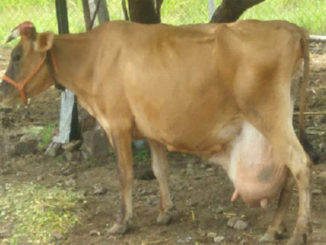Goat farming is one of the principal livelihoods of livestock farmers in Kandi area of Punjab and beetle is the major breed available in the area. These goats are seasonal breeders. Most of the goats are ready for breeding only during winter months when the nights are longer. They usually become anoestrus during summer months of March through August. A few goats fail to exhibit heat even during most favourable period of breeding and pseudo-pregnancy is one of the likely causes of this problem (anoestrus).

When the goat becomes pregnant, a yellow coloured body known as corpus luteum erupts on the ovary in the same place where the follicle gets ovulated. This corpus luteum acts as a temporary endocrine gland. A hormone called progesterone begins to appear in blood stream. This hormone is responsible for maintaining pregnancy throughout the gestation period.
The cycling goats also exhibit development of temporary structure, the corpus luteum, on the ovary following oestrus. However, this structure is broken down by another chemical substance known as prostaglandin F (PGF2a) which is produced by non gravid uterus. Once the source of progesterone is knocked down, the animal initiates another oestrous cycle and the goat comes into heat after an interval of about three weeks.
On certain occasions, the corpus luteum does not get dissolved in spite of goat being non-pregnant. It continues to produce and secrete progesterone. This progesterone activates a negative feedback mechanism which blocks production and release of reproductive hormones from the brain of the animal leading to stoppage of oestrous cycle. Sterile mucus like material starts accumulating in the uterine cavity after about a month. Usually, it is 2-4 litres in bulk. Occasionally, its amount could go up to 12 litres. Accumulation of this fluid makes the belly of the animal to bulge out just similar to state of pregnancy. However, this bulge is bilateral. The udder of the animal also appears to have developed significantly. Both these signs make the goat appear to be pregnant. However, in reality, she is non-pregnant. A few affected goats even start showing signs of labour pains like straining and mucus discharge from vulva. When the non-pregnant goat starts showing apparent signs of pregnancy, the condition is known as pseudo, false or phantom pregnancy or more technically pseudocyesis.
Sometimes, the pregnant goat experiences death of the developing foetus. The dead foetus remains inside the uterine cavity and the corpus luteum continues to remain active by producing progesterone. Under such circumstances, uterus starts accumulating mucus like material.
The does usually become docile once they become pregnant. However, pseudo-pregnant does show no change in behaviour. They remain aggressive jumping here and there even with bulging bellies.
The incidence of false pregnancy is more common in older and multiparous goats. The goats become more prone to development of this condition when they are treated with hormones to bring them into heat during non-breeding season. Deliberate skipping of natural service at the time of heat can also lead to development of phantom pregnancy.
This condition usually occurs only once in lifetime of a goat. However, a few goats can exhibit this abnormality repeatedly. Some genetic linkages have also been established. The lambs born to goats that have previously experienced pseudocyesis are more likely to develop this condition.
The condition of pseudo-pregnancy cannot be detected by estimating blood progesterone levels. These levels are usually similar in both pregnant and pseudo-pregnant goats. It is best diagnosed with ultrasonography. The pregnancy status in goats is usually determined with the help of ultrasound machines operated by experienced veterinarians. The cases of false pregnancy are usually detected at such maneuvers (i.e. cyesiognosis). The goats with unusually enlarged bellies are also put to ultrasonographic examination. The rectal probes can detect this condition 35-40 days after natural service while the abdominal probes are able to detect false pregnancy at 60-70 days of apparent gestation. The abdominal probes are usually placed on lower edge of left flank region of the animal.
One should keep in mind the fact that even the most experienced experts in ultrasounds do commit mistakes. The ultrasound findings must be correlated with historical background as well as with existing signs before instituting any type of treatment. Otherwise, one can lose valuable kids. One can also examine the texture of the udder to differentiate the condition. The udder of false pregnant does is not tight enough and it is not so shining.
The state of false pregnancy can exist up to a period of 120-150 days. Thereafter, it gets resolved automatically. When the problem still exists, it can be treated successfully with prostaglandins. Prostaglandins can also be employed as soon as the problem is diagnosed. Prostaglandins knock down the temporary corpus luteum present on the ovary. The progesterone level in blood circulation falls dramatically. This allows opening of cervix 2-3 days after the treatment. Uterine contractions lead to evacuation of all the contents. On many occasions, single shot of prostaglandin is sufficient to cause complete evacuation of uterine contents. In case of partial voidance, a second injection of prostaglandins can be given 11 days after the first shot. The fluid voided is mostly translucent but it can have a yellowish or grayish tinge. However, it is always odourless.
When the affected goats undergo treatment during the favourable breeding season, they come into heat within a week. They also get conceived when mated by a sound breedable buck. A few goats can even start lactating following prostaglandin treatment. Milking should be encouraged in such cases since it causes release of oxytocin from posterior pituitary. This oxytocin will improve uterine contractions helping in further evacuation of uterine contents.
Thus, awareness of false pregnancy in goats can avoid unnecessary financial losses to goat farmers.







Be the first to comment